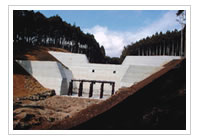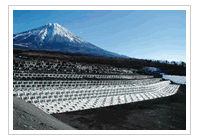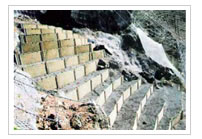Mt. Fuji & Sabo Project
Front Page>
Mt. Fuji & Sabo Project >
Project Overview >
What's "Sabo"
What's "Sabo"
Sediment disasters have been threatening people's lives from ancient times.
In Japan, incorporating the sediment disaster control technology of Europe have been promoting its own research from the Meiji period. Now, our advanced disaster control technology have much been improved than other countries. It has also been known around the world as the international word of SABO.
It is said that the word root SABO was from the official notice title "土砂溢漏防止(Dosya Rouei Boushi - Flood and Sediment-related disaster Prevention)" of Minbu-sho (Ministry of Popular Affairs in the Meiji period). After that, they picked up two Chinese characters (a.k.a. ‘kanji’) from the title, and began to call it "土砂溢漏防止*" SABO.
In Japan, incorporating the sediment disaster control technology of Europe have been promoting its own research from the Meiji period. Now, our advanced disaster control technology have much been improved than other countries. It has also been known around the world as the international word of SABO.
It is said that the word root SABO was from the official notice title "土砂溢漏防止(Dosya Rouei Boushi - Flood and Sediment-related disaster Prevention)" of Minbu-sho (Ministry of Popular Affairs in the Meiji period). After that, they picked up two Chinese characters (a.k.a. ‘kanji’) from the title, and began to call it "土砂溢漏防止*" SABO.
Debris flow countermeasure facilities
The facilities for SABO, have three types of facilities.1.Sabo Dam
 |
|
2.Groundsill Works
 |
|
3.Hillside Works
 |
|





















